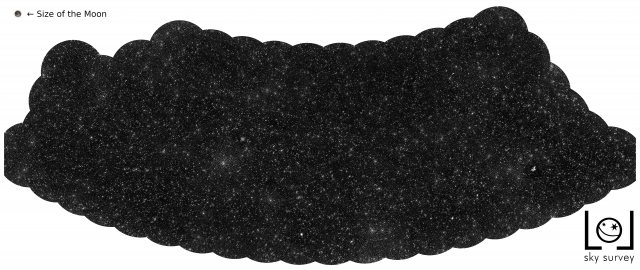A starry sky made of more than 25,000 supermassive black holes
02-03-2021
Based on a communication from the international team of scientists
An international team of astronomers, including two scientists from Poland Krzysztof Chyży from Jagiellonian University and Katarzyna Małek from National Centre for Nuclear Research, led by Junior Professor Francesco de Gasperin from Universität Hamburg, has produced the largest and sharpest map of the sky at ultra-low radio frequencies. The map published in the journal Astronomy & Astrophysics reveals more than 25,000 active supermassive black holes in distant galaxies.
At a first glance, the map looks like an image of a starry night sky. However, the map is based on data taken by the radio telescope LOFAR and shows the sky in the radio band. Stars are almost invisible in the radio band, but instead black holes dominate the picture. With this map, astronomers seek to discover celestial objects that only emit waves at ultra-low radio frequencies. Such objects include diffuse matter in the large scale structure of the Universe, fading jets of plasma ejected by supermassive black holes, and exoplanets whose magnetic fields are interacting with their host stars. Albeit among the largest of its kind, the published map only shows two percent of the sky. The search for these exotic phenomena will continue for several years until a map of the entire northern sky will be completed.
The radio waves received by LOFAR and used for this work are up to six meters long which corresponds to a frequency of around 50 MHz. They are the longest radio waves ever used to observe such a wide area of the sky at this depth. “The map is the result of many years of work on incredibly difficult data. We had to invent new strategies to convert the radio signals into images of the sky, but we are proud to have opened this new window on our Universe.”, says Francesco de Gasperin, scientist at the Hamburg Observatory and leading author of the publication.
There is a reason why the Universe at these long radio wavelengths is almost uncharted: such observations are very challenging. The ionosphere, a layer of free electrons that surrounds the Earth, acts as a lens continuously moving over the radio telescope. The effect of the ionosphere can be compared to trying to see the world while being submerged in a swimming pool. Looking upwards, the waves on the water bend the light rays and distort the view. To account for ionospheric disturbances, the scientists used supercomputers and new algorithms to reconstruct its effect every four seconds over the course of 256 hours of observation.
LOFAR is currently the largest radio telescope operating at the lowest frequencies that can be observed from Earth. It consists of 52 stations spread across nine different countries: The Netherlands, Germany, Poland, France, United Kingdom, Sweden, Ireland, Latvia, and Italy. LOFAR is a joint project of ASTRON, the Netherlands Institute of Radio Astronomy, and the universities of Amsterdam, Groningen, Leiden, Nimwegen as well as the German Long Wavelength Consortium (GLOW) to which Universität Hamburg belongs and polish POLFARO (which manages three stations in Poland) financed by Ministry of Science and Higher Education,
Original paper: F. de Gasperin et al., “The LOFAR LBA Sky Survey. I. Survey description and preliminary data release", Astronomy & Astrophysics, 2021
Link to arxiv release: https://arxiv.org/abs/2102.09238





